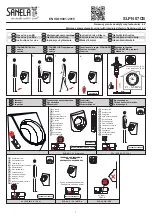
Info
I box doccia
J•TOWER
prevedono due tipi di piatto doccia:
piatto doccia alto:
piatto rialzato dal pavimento con piedini regolabili e pannello
di chiusura anteriore.
piatto doccia basso:
piatto monoblocco a diretto contatto con il pavimento, senza
piedini regolabili, senza pannello di chiusura anteriore e con pi-
letta di scarico incassata a pavimento.
È prevista l’installazione ad angolo e ad incasso, su pareti fini-
te e già rivestite, ma prive di zoccolo battiscopa e/o “torelli”,
modanature, sporgenze.
Se si desidera incassare il piatto sotto il rivestimento del muro,
bisogna tener conto che tale rivestimento non deve superare
lo spessore di 1,5 cm.
In questo caso, si raccomanda di siliconare tra piatto e muro,
nonché di interporre una guarnizione di almeno 5 mm tra pia-
strella e piatto.
IMPORTANTE: verificare all’arrivo l’integrità della merce, per un
eventuale e tempestivo reclamo allo spedizioniere.
Predisposizioni scarico e allacciamenti idraulici
Si consiglia di predisporre lo scarico del box doccia in pos. 1 in
modo diverso a seconda del tipo di piatto scelto (alto o basso)
e dell’installazione ad angolo, o ad incasso (Set).
Con il
piatto alto
si consiglia di predisporre lo scarico a muro,
a filo pavimento; in fase d’installazione si potrà collegare age-
volmente la piletta con un tubo flessibile, anche con il box doc-
cia già montato.
Con il
piatto basso
lo scarico dovrà essere incassato nel pavi-
mento, data la mancanza di spazio per la piletta.
Per l’allacciamento alla rete idrica acqua calda-fredda usare tu-
bi di rame minimo Ø 14mm, o tubi equivalenti.
Le uscite a pavimento dovranno essere predisposte come in fi-
gura e terminare con un attacco maschio da 1/2” (pos. 5).
In funzione del tipo d’installazione scelto (piatto basso o piat-
to alto), bisognerà lasciare più o meno lunghi i suddetti tubi ri-
spetto al pavimento.
Si raccomanda il rispetto delle quote indicate, tenendo anche
conto di come si installerà il piatto doccia (sotto o contro il ri-
vestimento del muro).
Si consiglia inoltre di non prevedere giunzioni sui tubi di ali-
mentazione, in modo da evitare perdite di carico e quindi una
diminuzione di potenza dei getti.
Per un corretto funzionamento degli idrogetti, devono essere
garantite le pressioni e portate dell’impianto idrico che ali-
menta il box doccia, come indicato nella tabella “Caratteristi-
che Idrauliche”.
Info
The
J•TOWER
shower stalls can be equipped with two types
of tray:
high tray:
the tray is raised above the floor and has adjustable feet and
a front closing panel;
low tray:
the single-block tray directly touches the floor, does not have
adjustable feet or front closing panel, and its drain is embed-
ded in the floor.
Provision has been made for installation in a corner and for em-
bedded installation, on walls that are already finished and tiled
but do not have a skirting board and/or borders, cornices or pro-
jections.
If the tray is to be embedded under the wall tiling, it is neces-
sary to allow for the fact that the thickness of the tiling must
not exceed 1.5 cm.
In this case, it is advisable to apply silicone between the tray
and the wall, and to interpose a gasket of at least 5 millime-
tres between the tiles and the tray.
IMPORTANT! As soon as the goods arrive, check their in-
tegrity, in order to be able to complain promptly with
the forwarding agent, if necessary.
Preparations for drain and water connections
It is advisable to prepare the drain of the shower stall in posi-
tion 1 in different ways, depending on the type of tray that has
been chosen (high or low) and on the fact that the shower
stall is installed in a corner or embedded (SET).
With the
high tray
, we recommend that you prepare the wall
drain flush with the floor; during the installation it will be pos-
sible easily to connect the drain to a hose, even with the show-
er stall already assembled.
With the
low tray
, the drain must be embedded in the floor,
because there is no room for it.
For the connection to the water network, use copper pipes
with a diameter of at least 14 millimetres, or equivalent pipes.
The outlets on the floor must be prepared as shown in the fig-
ure and must end with a 1/2” male connection (pos. 5).
Depending on the type of installation that has been chosen
(high or low tray), it will be necessary to leave these pipes more
or less long with respect to the floor.
It is important to comply with the dimensions that have been
indicated, and also to allow for the way in which the tray will
be installed (under or against the wall tiling).
It is advisable, moreover, not to make joints in the supply pipes,
in order to avoid a leakage that would decrease the force of the
jets.
For a correct operation of the water jets, it is necessary to en-
sure the appropriate pressure and flow rate of the water sys-
tem that supplies the shower stall, as indicated in the table of
the hydraulic specifications.
3
Summary of Contents for J-Tower
Page 23: ......




































